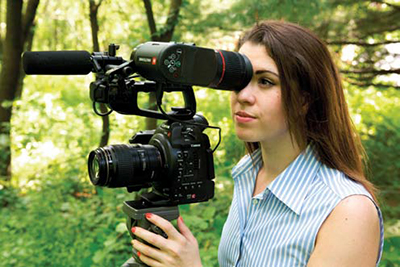The Kinotehnik LCDVFe Electronic Viewfinder
Kinotehnik has created the LCDVFe, a universal electronic viewfinder with an extremely sharp display that attaches to the hotshoe of most cameras and DSLRs. Those who might have difficulty focusing on the DSLR’s LCD screen at close range will find the option of an electronic viewfinder easier and more convenient to use.
FEATURES
The LCDVFe looks much like the viewfinder you would see on a standard, shoulder- mounted camcorder. This three-inch color viewfinder has an 800 x 480 resolution and can be viewed through the diopter- adjusted eyepiece or flipped open like any other LCD screen. The kit accompanying the LCDVFe contains everything you need to mount the external viewfinder to your camera.
The unit itself weighs less than a pound and features a rubber eyepiece on the viewing end, a full-size (type A) HDMI input and output, as well as a USB input. The side features a touch-sensitive power button, menu, four directional arrows and an F1 and F2 selection. Most of the weight of the electronic viewfinder is the four AA battery holder that DC powers the unit (an AC option is available).
The rest of the kit contains the D-tap DC cable to power the unit through a brick battery, two battery cartridges for quick changing of AA battery supplies, a 15 mm carbon-fiber rod, a 15 mm rod clamp to quarter-inch thread adapter and a 90-degree rod clamp that mounts to your camera’s hotshoe.
The unit powers on instantly and displays exactly what the HDMI exports. The menu option features a multitude of settings such as control of the display (brightness, contrast, and saturation), video display (cropping, zooming, and formatting), grid guides (crop, safe area, center cross, color, and format), functions (exposure, focus assist, and image effect) and on screen displays (viewfinder battery display, histogram, and audio metering).
The accompanying user manual is even easy to understand as this electronic viewfinder was designed by a cameraman.
IN USE
Right out of the small box, the LCDVFe was relatively simple to assemble. I found the four-AA battery holder (a spare is included) a bit awkward to install, but once it was seated the viewfinder powered up with a push of a button. I should mention that the buttons are soft-touch style and could get damaged if used with sharp fingernails.

The Kinotehnik LCDVFe electronic viewfinder The most amazing thing about the unit is the clarity of its 1.2 megapixel viewfinder. I attached the unit to my Canon EOS C100 as this camera’s viewfinder is impossible to use by anyone possessing a nose. (If I have to rely on the camera’s LCD screen, I have difficulty focusing at such close distances with my bifocal-enabled eyes. This viewfinder is a godsend to anyone with this condition.)
If looking through a viewfinder isn’t your bag, the eyepiece part flips up to allow you to view the three-inch LCD screen. However, in my opinion this defeats the purpose of the viewfinder option.
One negative I noticed in connection with the LCDVFe is the weight it adds to the camera package. While it’s only a pound, having it on top of the camera makes balancing things awkward. The second was that with the viewfinder attached, the C100 no longer fit in its carrying case. However, these are just minor distractions.
Looking forward to my first shoot with the LCDVFe, I mounted it via the hot shoe mount and attached the camera’s “HDMI out” to the viewfinder’s “HDMI in.” After a push of the power button and a slight angling of the viewfinder to reach my eye, I adjusted the diopter to sharpen the image. A red tinge surrounded the image, alerting me to the fact that I needed to adjust the camera’s focus.
Having the image this close to my eye helped me frame my shots much more easily. I quickly found out that being able to shoot while still keeping my glasses on saved a lot of time—without the LCDVFe I was constantly taking my glasses off and then putting them back on when operating the camera.
Using the viewfinder with shoulder-mounted rigs was also helpful, as I could keep the camera to my eye and still watch where I was going with my glasses-corrected vision in the other eye. Again, the eyepiece does add extra weight, especially when hand-holding the camera.
Outdoor use is really where the LCDVFe earns its keep. In brilliant sunshine, I was still able to see exactly what the camera saw. I was even able to play back the footage and observe it though the eyepiece. (I think that all of us would agree that in full sun, the LCD screen of a DSLR is useless without shading it or using an external, shaded monitor.)
SUMMARY
For those using a DSLR camera without an external viewfinder and who have difficulty focusing in close proximity to the LCD screen, the LCDVFe is a comfortable solution. Seeing a 1:1 representation of what is displayed on the camera’s LCD, it makes extended shooting that much more palatable—especially outdoors.
Chuck Gloman is chair and associate professor of the TV/Film department at DeSales University. He may be contacted atchuck.gloman@desales.edu.
FAST FACTS
Application
For shooting with DSLRs when the built-in LCD screen isn’t easy to see due to lighting conditions, or by someone who wears corrective lenses that don’t allow easy viewing of the camera’s screen.
Key Features
Uses AA battery or AC-power, a three inch display with all of the features available on most LCD screens and it brings important information closer to the user’s eye.
Price
MSRP, viewfinder only, $980; the complete kit is $1,240. (An HDSDI to HDMI converter, if needed, is available for $295.)
Contact
Manios Digital & Film, a division of Ste-Man, Inc.
800-845-6619
www.maniosdigital.com
Get the TV Tech Newsletter
The professional video industry's #1 source for news, trends and product and tech information. Sign up below.
Chuck Gloman is Associate Professor with the TV/Film Department at DeSales University.

